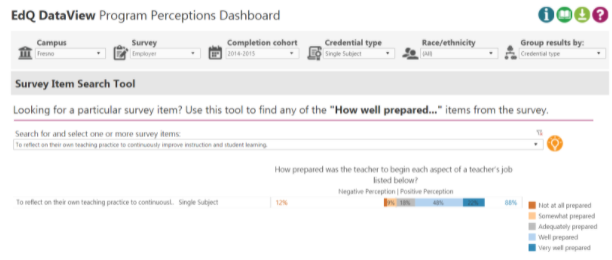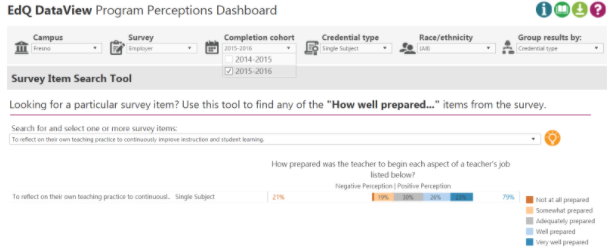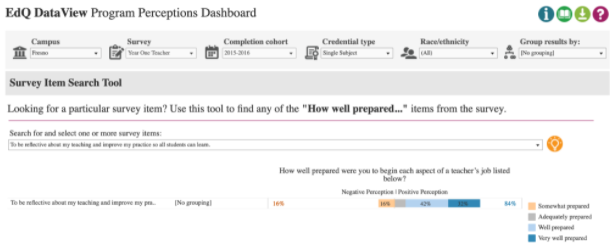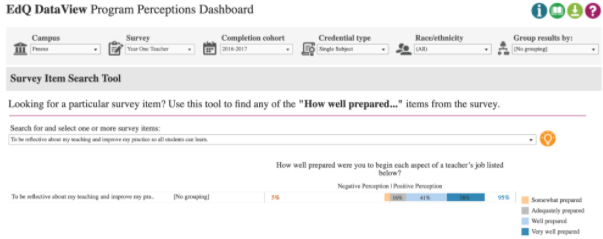AAQEP Accreditation
Standard 2 Aspect E
Standard 2: Program completers engage in professional practice in educational settings and show that they have the skills and abilities to do so in a variety of additional settings and community/cultural contexts. For example, candidates must have broad and general knowledge of the impact of culture and language on learning, yet they cannot, within the context of any given program, experience working with the entire diversity of student identities, or in all types of school environments.
Candidate preparation includes first-hand professional experience accompanied by reflection that prepares candidates to engage effectively in different contexts they may encounter throughout their careers.
Data Sources & Analysis
Data Source 1
CSU Educator Quality Center Employer Survey
Definition of Data Source:
The CSU Educator Quality Center administered a survey to employers of 2014-2015 and
2015-2016 graduates of CSU educator preparation programs. Results were able to be
disaggregated by both preparatory institution and program. The survey was discontinued
after evaluating the 2015-2016 completers, meaning that all available data are at
least five years old. The California Commission on Teacher Credentialing (CCTC) began
its own employer survey that it first administered in Fall 2019. However, while it
is possible to disaggregate results by institution, it is not possible to do so by
preparation program. In the future, we plan to advocate to the CCTC for the addition
of items to the survey that would allow data to be disaggregated in this way.
Although the data from the CSU Employer Survey are dated, we chose to use the results anyway as one of our three data sources because they do provide an employer perspective on our candidates. Additionally, the results provide us with a baseline to which we can compare results collected in the future.
Employers are invited to respond to each item on a 1-5 scale to indicate their perception of the completers’ level of preparation, with 1 indicating not at all prepared, 2 indicating poorly prepared; 3 indicating adequately prepared; 4 indicating well prepared and 5 indicating very well prepared.
Perspective Captured from Data Source: Employer
Specific Elements of Data Source:
The CSU Educator Quality Center Employer Survey item selected to evaluate employers’
perceptions of completers’ ability to evaluate their own professional growth and engage
in self-assessment, goal setting, and reflection was as follows:
How well prepared was the teacher to reflect on their own teaching practice to continuously improve instruction and student learning?
Definition of Success for Each Element:
Programmatically, our goal is for our school district employers to rank the candidates
they hired as either “well,” or “very well” prepared once they exited our program.
Displays of Analyzed Data
Figure 1. CSU Educator Quality Center Employer responses to the item related to 2014-2015 program
completers’ ability to evaluate their professional growth and engagement in self-assessment,
goal setting, and reflection.
Figure 2. CSU Educator Quality Center Employer responses to the item related to 2015-2016 program
completers’ ability to evaluate their professional growth and engagement in self-assessment,
goal setting, and reflection.
Link to Full Dataset: The link to the full dataset is unavailable. However, if reviewers would like to view the CSU Educator Quality Center Data Dashboards, we are happy to set up a time to provide them access by sharing screens in a Zoom session.
Interpretation of Data:
Sixty-five employers responded to the CSU Educator Quality Center survey evaluating
the preparedness of the 2014-2015 cohort of candidates (Figure 1). Overall, 88% indicated
that our candidates were “prepared” to reflect on their own teaching practice to continuously
improve instruction and student learning. Of those, 21.50% (n=14) rated our candidates
as “very well” prepared, 47.70% (n=31) indicated they were “well prepared,” and 18.50%
(n=12), marked them as “adequately” prepared.
For the CSU Educator Quality Center survey evaluating the preparedness of the 2015-2016 cohort of candidates (Figure 2), 79% of the 57 employers who responded indicated that our candidates were “prepared” to reflect on their own teaching practice to continuously improve instruction and student learning. Of those, 22.80% (n=13) rated our candidates as “very well” prepared, 26.30% (n=15) felt they were “well prepared,” and 29.80% (n=17), marked them as “adequately” prepared.
Across both years, findings indicate that, overall, responding employers believed our program completers were prepared to evaluate their professional growth and engagement in self-assessment, goal setting, and reflection. Still, in 2016-2017, only 49% of the 57 responders indicated the teachers they supervised were well or very well prepared in this area, which suggests this may be an area that needs further focus within the program.
Data Source 2
CCTC Program Completer Survey
Description of Data Source:
The California Commission on Teacher Credentialing administers a survey annually to
all individuals in the state when they apply for a credential. The survey seeks to
collect candidates’ perceptions of their preparation program and is organized under
the six domains of the Teaching Performance Expectations (TPEs).
CCTC Program Completers responded to each survey item on a 1-5 scale, with 1 indicating “not at all” prepared, 2 indicating “poorly” prepared; 3 indicating “adequately” prepared; 4 indicating “well” prepared, and 5 indicating “very well” prepared.
Perspective Captured from Data Source: Program Completer
Rationale for using Data Source:
Although the survey gathers data from candidates at the time they complete the program,
we believe that their perceptions of the program at this point help us to know if
they feel ready to establish goals for their own professional growth and engage in
self-assessment, goal setting, and reflection.
Specific Elements of the Data Source:
Having an understanding of how one's actions impact student learning and modifying
those actions leads to the development of one’s own goals for professional growth.
As a result, the CCTC Program Completer Survey item relating to the establishment
of one’s own professional growth and engagement in self-assessment was:
How well did your preparation program prepare you to:
- Evaluate the effects of your actions on student learning and modify those plans accordingly.
Definition of Success for Each Element:
Programmatically, our goal is for our candidates to rate themselves as either “well,”
or “very well” prepared after they have completed the program.
Displays of Analyzed Data
Table 1. 2017-2018 CCTC Program Completer Survey responses for program perception items related to their own professional growth and engagement in self-assessment, goal setting, and reflection.
Table 1. Responses to CCTC Completer Survey items related to creating positive learning environments (Full Dataset)
| Rating | 2016-2017 (n=79) |
2017-2018 (n=187) |
2018-2019 (n=177) |
2019-2020 (n=165) |
|---|---|---|---|---|
| Not at all | 0 (0%) | 1 (0.5%) | 2 (1.1%) | 1 (0.6%) |
| Poorly | 2 (2.5%) | 6 (3.2%) | 6 (3.4%) | 6 (3.7%) |
| Adequately | 15 (19.0%) | 41 (21.9%) | 37 (20.9%) | 31 (18.9%) |
| Well | 32 (40.5%) | 76 (40.6%) | 61 (34.5%) | 61 (37.2%) |
| Very well | 30 (37.9%) | 63 (33.7%) | 71 (40.1%) | 65 (39.6%) |
Interpretation of Data:
For the 2016-2017 CCTC Program Completer surveys, 97.5% of responders indicated they
felt prepared to evaluate the effects of their own actions on student learning and
modify plans accordingly. Of these 30 respondents, 37.9% (n=30) rated themselves as
“very well” prepared, 40.5% (n=32) felt “well prepared,” and 19.0% (n=15) marked themselves
as “adequately” prepared.
For the 2017-2018 CCTC Program Completer surveys, 96% of responders indicated they felt prepared to evaluate the effects of their own actions on student learning and modify plans accordingly. Of these 187 respondents, 33.7% (n=63) rated themselves as “very well” prepared, 40.6% (n=76) felt “well prepared,” and 21.9% (n=41) marked themselves as “adequately” prepared.
For the 2018-2019 CCTC Program Completer surveys, 95% of responders indicated they felt prepared to evaluate the effects of their own actions on student learning and modify plans accordingly. Of these 177 respondents, 40.1% (n=71) rated themselves as “very well” prepared, 34.5% (n=61) felt “well prepared,” and 20.9% (n=37) marked themselves as “adequately” prepared.
For the 2019-2020 CCTC Program Completer surveys, 95% of responders indicated they felt prepared to evaluate the effects of their own actions on student learning and modify plans accordingly. Of these 164 respondents, 39.6% (n=65) rated themselves as “very well” prepared, 37.2% (n=61) felt “well prepared,” and 18.9% (n=3), marked themselves as “adequately” prepared.
Across all three years, a large majority of program completion preliminary credential applicants rated themselves as “well” prepared in establishing their own professional growth and engagement in self-assessment, goal setting, and reflection.
Data Source 3
CSU Educator Quality Center Year One Teacher Survey
Description of Data Source:
For candidates who completed a CSU educator preparation program each academic year
from 2014-2015 to 2017-2018, the CSU Educator Quality Center administered a year-out
survey to learn how well the educators, after their first year in the field, believed
the program had prepared them. Year One Teachers respond to each item on a 1-5 scale,
where 1 indicates they were not at all prepared, 2 indicates they were poorly prepared;
3 indicates they were adequately prepared; 4 indicates they were well prepared and
5 indicates they were very well prepared.
Due to the challenges of educators in Spring 2020, the CSU Educator Quality chose not to administer the survey at that time, meaning data are not available for candidates who completed in 2018-2019. Survey administration began again in Spring 2021, and we look forward to analyzing those data when they become available.
Perspective Captured from Data Source: Year One Teacher
Rationale for using Data Source:
The CSU Educator Quality Center survey captures the perspectives of program completers
after their first year of teaching. Items on the survey invite candidates to share
how well they believe the program prepared them in several key areas.
Specific Elements of Data Source:
The item selected for analysis related to establishing goals for their own professional
growth and engaging in self-assessment, goal setting, and reflection include:
How well prepared were you:
- To be reflective about my teaching and improve my practice so all students can learn;
Data Measurement
Year One Teachers respond to each item on a 1-5 scale, where 1 indicates they were
not at all prepared, 2 indicates they were poorly prepared; 3 indicates they were
adequately prepared; 4 indicates they were well prepared and 5 indicates they were
very well prepared.
Definition of Success for Each Element:
Programmatically, our goal is for all Year One teachers to indicate they were either
well or very well prepared in each area.
Displays of Analyzed Data
Figure 3. 2016-2017 Year One Teacher Survey Responses from 2015-2016 Completers for Program
Perception Items Related to professional growth and engagement in self-assessment,
goal setting, and reflection.
Figure 4. 2017-2018 Year One Teacher Survey Responses from 2016-2017 Completers for Program
Perception Items Related to professional growth and engagement in self-assessment,
goal setting, and reflection. 
Figure 5. 2018-2019 Year One Teacher Survey Responses from 2017-2018 Completers for Program
Perception Items Related to professional growth and engagement in self-assessment,
goal setting, and reflection.
Link to Full Dataset: The link to the full dataset is unavailable. However, if reviewers would like to view the CSU Educator Quality Center Data Dashboards, we are happy to set up a time to provide them access by sharing screens in a Zoom session.
Interpretation of Data:
Looking across the three years of data, findings show that nearly three-quarters of
responding first year teachers indicated they were well or very well prepared to be
reflective about their teaching and improve their practice so all students could learn.
What’s more, no responders indicated they were not at all prepared, and only 12% of
the 2018-2019 responders indicated they were only somewhat prepared. These results
suggest that, overall, the program is doing well in this area.
Next Steps:
Overall, responses to all three surveys indicate that completers of our program are
prepared to establish goals for their own professional growth and engage in self-assessment,
goal setting, and reflection. In all measures, the majority of respondents indicated
the program had prepared candidates well or very well. Still, if we hold on to the
belief that we want all employers, completers, and year-out teachers to indicate the
program prepares candidates well or very well, there is still work to do.
It is also apparent from the data sources used in this standard (2E) that even though our candidates might possess the ability to set goals, we cannot determine whether or not they possess the ability to accomplish these goals as there are no questions on any of the surveys that address this ability. As a result, there needs to be a better measure in place that captures our candidates ability to accomplish their goals during their employment. A reflective measure that could be used is the Individual Induction Development Plan (IIDP). The IIDP is a form that is completed during “final” student teaching by the candidate in deliberation with their university coach that identifies two California Teacher Performance Expectation (TPE) goals that will be addressed during their first two years of employment. The downside to this idea is that there is no system in place as of yet to determine if in fact the credential candidates accomplishes their self-identified TPE goals. However, the hiring of a Data Management Coordinator has necessitated a systematic IIDP follow-through plan.
Another area the program should investigate in the future is candidates’ scores on the Fresno Assessment of Student Teachers (FAST) Teaching Sample Project, particularly the area in which candidates self-assess and reflect on their instruction. Examining scores on this measure and providing further support will better prepare completers for the ongoing reflection that is critical to providing high-quality instruction.